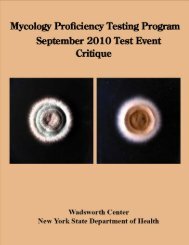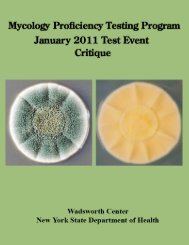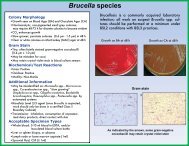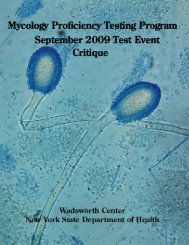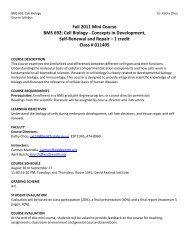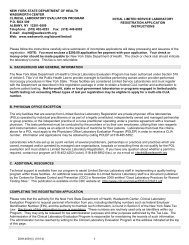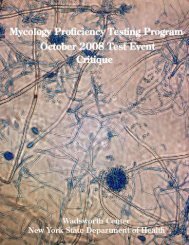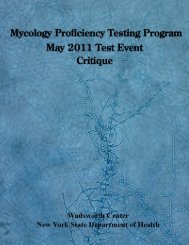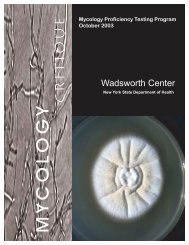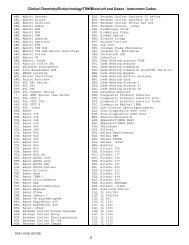September 2007 - Wadsworth Center
September 2007 - Wadsworth Center
September 2007 - Wadsworth Center
You also want an ePaper? Increase the reach of your titles
YUMPU automatically turns print PDFs into web optimized ePapers that Google loves.
Alignment of primary sequence of the ITS2 regions of C. dubliniensis YN57-151205 and PT specimen C. dubliniensis NYSDOH0907.Further Reading:1. Alves, S.H., de Loreto, E.S., Linares, C.E., Silveira, C.P., Scheid, L.A., Pereira, D.I., Santuario, J.M.2006. Comparison among tomato juice agar with other three media for differentiation of Candidadubliniensis from Candida albicans. Rev Inst Med Trop Sao Paulo. 48: 119-21.2. Brito Gamboa, A., Mendoza, M., Fernandez, A., Diaz, E. 2006. Detection of Candida dubliniensis inpatients with candidiasis in Caracas, Venezuela. Rev Iberoam Micol. 23: 81-84.3. Cardenes-Perera, C.D., Torres- Lana, A., Alonso-Vargas, R., Moragues-Tosantas, M.D., Emeterio, J.P.,Quindos-Andres, G., Arevalo-Morales, M.P. 2004. Evaluation of API ID 32C® and Vitek-2® to identifyCandida dubliniensis. Diagn Microbiol & Infect Dis. 50: 219 – 221.4. Graf, B., Trost, A., Eucker, J., Gobel, U.B., Adam, T. 2004. Rapid and simple differentiation of C.dubliniensis from C. albicans. Diagn. Microbiol. & Infect Dis. 48: 149 – 151.5. Jabra-Rizk, M.A., Johnson, J.K., Forrest, G., Mankers, K., Meiller, T.F., Venezia, R.A. 2005. Prevalenceof Candida dubliniensis fungemia at a large teaching hospital. Clin Infect Dis. 41: 1064 – 1067.6. Mirhendi, H., makimura, K., Zomorodian, K., Maeda, N., Ohshima, T., Yamaguchi, H. 2005.Differentiation of Candida albicans and Candida dubliniensis using a single enzyme PCR-RFLPmethod. Jpn J Infect Dis. 58: 235 – 237.7. Nunn, M.A, Schäfer, S.M., Petrou, M.A., and Brown, J.R.M. <strong>2007</strong>. Environmental source of Candidadubliniensis. Emerg Infect Dis [serial on the Internet]. Available fromhttp://www.cdc.gov/EID/content/13/5/747.htm8. Salgado-Parreno, F.J., Alcoba-Florez, J., Arias, A., Moragues, M.D., Quindos, G., Ponton, J., Arevalo,M.P. 2006. In vitro activities of voriconazole and five licensed antifungal agents against Candidadubliniensis: comparison of CLSI M27-A2, Sensititre YeastOne, disk diffusion, and Etest methods.Microb Drug Resist. 12: 246-51.9. Schabereiter-Gurtner, C., Selitsch, B., Rotter, M.L., Hirschl, A.M., Willinger, B. <strong>2007</strong>. Development ofnovel real-time PCR assays for detection and differentiation of eleven medically important Aspergillusand Candida species in clinical specimens. J Clin Microbiol. [Epub ahead of print]10. Sullivan, D.J., Moran, G.P., Pinjon, E., Al-Mosaid, A., Stokes, C., Vaughan, C., Coleman, D.C. 2004.Comparison of the epidemiology, drug resistance mechanisms and virulence of Candida dubliniensis andCandida albicans. FEMS Yeast Research. 4: 369 – 376.11. Tsuruta, R., Oda, Y., Mizuno, H., Hamada, H., Nakahara, T., Kasaoka, S., and Maekawa, T. <strong>2007</strong>.Candida dubliniensis isolated from the sputum of a patient with end-stage liver cirrhosis. Intern Med. 46:597-600.12. Us, E and Cengiz, S.A. <strong>2007</strong>. Prevalence and phenotypic evaluation of Candida dubliniensis in pregnantwomen with vulvovaginal candidosis in a university hospital in Ankara. Mycoses. 50: 13-20.34



